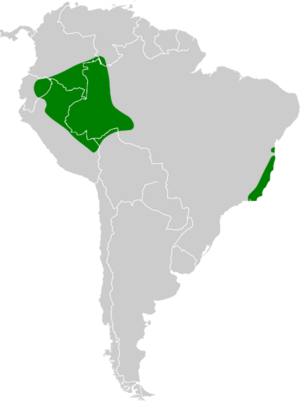Black-bellied thorntail facts for kids
Quick facts for kids Black-bellied thorntail |
|
|---|---|
 |
|
| Illustration of male | |
| Conservation status | |
| Scientific classification | |
| Genus: |
Discosura
|
| Species: |
langsdorffi
|
 |
|
| Synonyms | |
|
Popelairia langsdorffi (Temminck, 1821) |
|
The black-bellied thorntail (Discosura langsdorffi) is a tiny, colorful hummingbird. It's known for its long, forked tail, especially in males. This amazing bird belongs to a group of hummingbirds called "coquettes." You can find it in parts of South America. It lives in countries like Bolivia, Brazil, Colombia, Ecuador, Peru, and Venezuela.
Contents
Meet the Black-bellied Thorntail!
Scientists give every living thing a special name. This helps them organize and study nature. The black-bellied thorntail's scientific name is Discosura langsdorffi. For a while, scientists placed this bird in different groups. But now, most agree it belongs to the Discosura group.
There are two main types, or subspecies, of the black-bellied thorntail. They are D. l. langsdorffi and D. l. melanosternon.
What Does It Look Like?
The black-bellied thorntail is a very small bird. It weighs about 3.2 grams (0.11 ounces). That's less than a penny!
Male birds are about 12 to 13.7 centimeters (4.7 to 5.4 inches) long. Females are smaller, around 7.4 to 7.6 centimeters (2.9 to 3.0 inches).
Both male and female birds have bright, shiny feathers. Their heads are a sparkling emerald green. Their backs are a coppery green. They also have a white stripe across their lower back.
Male Birds
Males have a bright, iridescent green throat. This is called a gorget. Below it, they have a golden coppery band. Their sides are bronzy green. The rest of their belly is black.
Their tail is very special. It's deeply forked, like a swallow's tail. The outer feathers are very narrow. This gives the bird its "thorntail" name. The inner tail feathers are steely blue. The outer ones are gray.
Female Birds
Females have a white throat with green and black spots. They also have a thin white stripe on their cheek. Their chest is spotted green. Their belly is black with a white patch on the side.
Their tail is shorter than the male's. It's only slightly forked. It's steely blue with bronze at the base and white tips. Young birds look similar to the adult female.
Different Subspecies
The D. l. melanosternon subspecies is a bit smaller. Its head is grass green. Its chest is more golden. The rest of its belly is darker.
Where Does It Live?
The black-bellied thorntail lives in South America. The D. l. langsdorffi subspecies lives along the coast of eastern Brazil. It can be found from Bahia south to Rio de Janeiro.
The D. l. melanosternon subspecies lives in the Amazon rainforest. You can find it in southern Venezuela, southeastern Colombia, eastern Ecuador and Peru, northern Bolivia, and western Brazil.
These birds like to live in humid lowland forests. They usually stay between 100 and 300 meters (330 and 980 feet) above sea level. In the Amazon, they prefer "terra firme" forests. These are forests on higher ground that don't flood. They also live in areas between "terra firme" and "várzea" forests. "Várzea" forests are flooded seasonally.
How Does It Behave?
Movement
Scientists believe the black-bellied thorntail usually stays in one area. It does not seem to migrate or travel long distances.
Feeding
This hummingbird loves to drink nectar from many different kinds of flowers. It usually looks for food in the middle and upper parts of the forest. It also eats small arthropods, like insects. One female bird was even seen picking insects from a spider web!
Breeding
Black-bellied thorntails breed at different times depending on where they live. In eastern Brazil, they breed from November to February. In the Amazon, they breed from September to March.
The female builds a cup-shaped nest. She uses soft plant material and decorates the outside with lichen. She usually places the nest on a horizontal branch. It's often high up, about 10 to 35 meters (33 to 115 feet) above the ground.
The female lays two eggs. She sits on them for about 13 days to keep them warm. The baby birds leave the nest about 20 days after they hatch.
Sounds It Makes
The black-bellied thorntail is mostly a quiet bird. When it's feeding, it sometimes makes a short "tsip" or "chip" sound. Its wings also make a buzzing sound, like a bee, when it hovers in the air.
Is It Safe?
The IUCN (International Union for Conservation of Nature) says the black-bellied thorntail is a species of "Least Concern." This means that, overall, it is not considered to be in danger of disappearing.
However, its population size is not fully known. Scientists believe its numbers might be going down. It's often thought to be a rare bird. But it might just be hard to count because it stays high in the forest.
Its home, the forest, is facing a big threat from deforestation. This means forests are being cut down. The bird does not seem to like living in areas changed by humans. Luckily, it does live in some protected areas.



